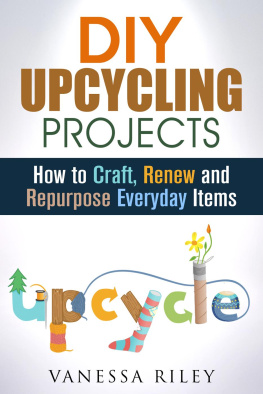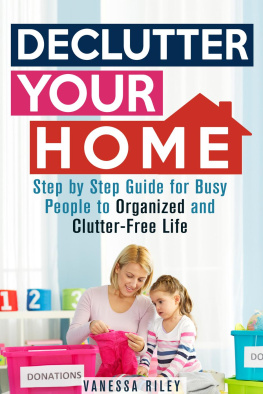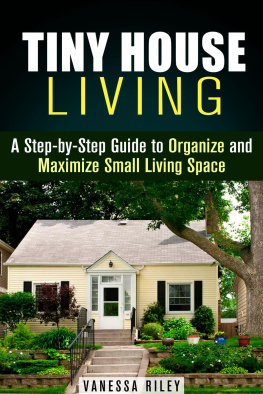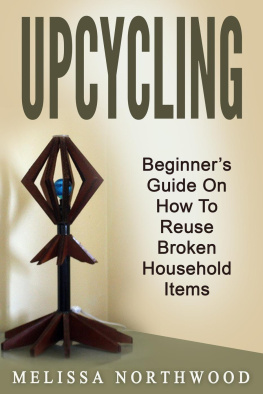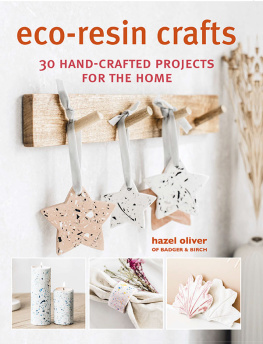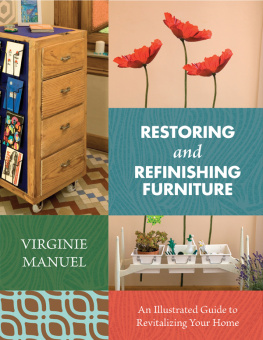DIY Upcycling Projects
How to Craft, Renew and Repurpose Everyday Items
Copyright Notice
Reproduction, duplication, transmission of this document in part or in whole is permitted only with written permission from the publisher. All rights reserved.
Respective brands and trademarks mentioned in this book belong to their respective owners.
Disclaimer
This document is geared towards providing summarization of information related to the topic. While all attempts have been made to verify the accuracy of the information, the author does not assume any responsibility for errors, omissions, or interpretations of the content. The information is offered for informational or entertainment purposes only. If professional advice is necessary, a qualified legal, medical, financial or another respective professional should be consulted. The reader is responsible for his or her own actions. The publisher does not accept any responsibility or liability arising from damages or losses, real or perceived, direct or indirect, resulting from the use of this information.
Table of Contents
Introduction
A re you frustrated with how expensive it is to buy new furniture, decorations and household items? Do you want to spruce up your home, but dont want to spend a lot of money? Do you want to learn to renew, reuse and repurpose things you have around the house? This book will show you how to reduce your carbon footprint while saving money and crafting beautiful and easy-to-make items for your home.
Chapter 1 starts out with a basic description of upcycling. Reasons why reusing, renewing and repurposing items makes sense today are presented.
Chapter 2 discusses strategies and tips for renewing old furniture to create beautiful like-new pieces for your home. Detailed plans for crafting headboards and dressers will be presented.
Chapter 3 takes you step-by-step through the process of making useful and decorative items out of old picture frames. You will learn how to make stylish mirrors and attractive trays with your old picture frames.
Chapter 4 provides easy-to-follow plans for reusing wood from old pallets. You will learn how to create planters and patio furniture out of this discarded wood.
Chapter 5 gives you several ideas for easy-to-make household items out of common materials you have around the house. Learn to make useful and creative items out of materials you usually throw out!
Finally, the Best Practices and Common Mistakes section gives you useful Dos and Donts to remember as you start to craft, reuse, renew and repurpose items for your home and as gifts.
With these tips and strategies, you can start creating beautiful items for your home with old and discarded items from flea markets, thrift shops, or around your own home.
Chapter 1: What is Upcycling?
A number of people are interested in reducing their carbon foot print. Today most people want to reduce the amount of materials they use and simply throw away. Upcycling is an environmentally responsible way to reduce what we waste.
In this chapter, you will learn:
- What upcycling is.
- Why upcycling makes sense today.
- Where you can find items to upcycle.
What is Upcycling?
U pcycling is the process of reusing discarded items or materials to create useful and beautiful new items. Through upcycling you can take items that are no longer needed or wanted and transform them into creative and useful materials for your home. Upcycling adds value to your unwanted items. The purpose of upcycling is to create a more sustainable life by reducing the amount of materials that are discarded in landfills. Upcycling also improves the efficiency of how we use resources.
While the term might be new to you, examples of upcycling are all around you! Here are some upcycling examples you may have observed:
- Playground mats made of used tires
- Jewelry made from old coins or silverware
- Tables made from old wooden pallets
- Sculptures made from scrap metal
- Storage sheds made from old metal shipping containers
- Lamps made from old wine or beer bottles
The number of upcycling opportunities is limited only by your imagination. We can choose to reuse discarded items. We can renew old items and make them into new, beautiful versions. We can repurpose discarded materials into beautiful and useful household decorations, organizers, or furnishings. Unlike recycling, upcycling doesnt break down items into components that can be used to create other materials. Upcycling lets you transform trash into treasures. You get a value added product and our environment becomes a little more sustainable.
Why does Upcycling Make Sense Today?
C hances are your parents and grandparents reused materials and items. Things just werent thrown away. Old clothes were remade into clothes for other family members. When the fabric became too worn to be reused as a short or dress, it was made into a quilt or cut into pieces to be used as dust cloths. Old couches were recovered, not thrown out. Old furniture was repainted or refinished. Somewhere along the way, we became a disposable nation. When the paint chipped, we threw it out. When the curtains no longer matched our dcor, we discarded them. We used everything once and when it was no longer needed or wanted, we got rid of it and bought a new item.
Today there are a lot of reasons to upcycle our unwanted or unneeded items. Upcycling provides many benefits such as:
- Reduces the volume of trash sent to landfills
- Reduces the need to manufacture new materials
- Reduces air and water pollution associated with manufacturing of new materials
- Replaces mass produced items with hand crafted objects
- Salvages the remaining value from used objects
- Saves you money when you repurpose items rather than replacing them!
Where can You Find Materials to Use in Upcycling?
T here are opportunities all around you for upcycling. Here are some suggestions to get you started.
- Your house, garage, basement and attic . All of those items you no longer needed, but just couldnt part with are excellent materials for upcycling.
- Garage and yard sales . Look at what your neighbors are getting rid of. I have found beautiful picture frames, gently worn clothes and out of date curtains. I reused and repurposed these items into new decorations for my home.
- Free cycle . Look on line for what people are giving away. Many people will place ads on free cycle to get rid of unwanted items. All you have to do is pick it up and be creative! Heres the link https://www.freecycle.org/
- Auctions . At local auctions and estate sales, you can get some very cheap but valuable items. Recently I purchased a vintage 4 foot high radio. It didnt work so the owner didnt want it. With a little bit of furniture polish, I repurposed it into an attractive entry way table. It looks expensive and elegant and costs me very little money and time.
- Thrift stores . Thrift stores such as Salvation Army, Unique, Goodwill, Jumble and others offer a wide selection of used and potentially valuable items for you to upcycle.
- Bulk trash day . In our community once a month people can put out bulk items for the trash collectors to collect. You can drive around the neighborhood and help yourself. I have found structurally sound chairs and upholstered furniture, salvageable wooded furnishings, and a variety of decorative items that just needed a little love.
- Family and friends . Ask you relatives and friends to let you have a first look at anything they might throw out. I had one family member who was going to donate a complete dining room set consisting of a table, four chairs and a small china cabinet because she wanted a new one! I recovered the chairs and created a modern, chic dining room set!
Next page
